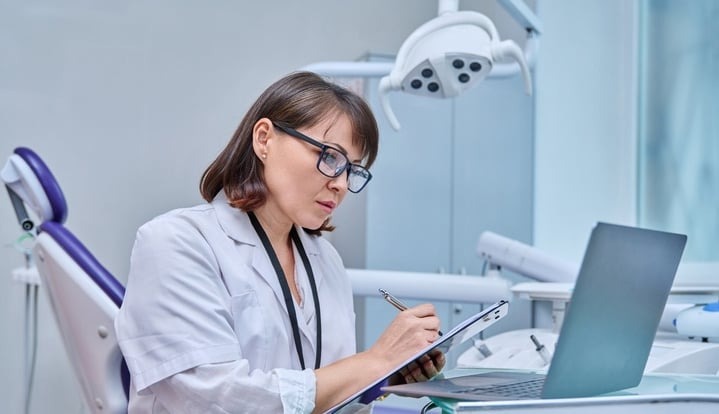The pace of dentistry has always been fast, but in recent years it’s begun to feel like a sprint. New materials, AI-driven diagnostics, 3D imaging, and digital workflows are changing the landscape every month. For dentists, staying current isn’t just a professional obligation; it’s part of delivering safe, confident care.
Continuing education (CE) once meant flying across the country for a weekend seminar. Today, technology has redefined how learning happens: flexible, personalized, and seamlessly integrated into the workday.
Learning Without Leaving the Clinic

It’s no longer about waiting for conferences to roll around. Now, dentists can access live-streamed lectures, modular online courses, and case-based discussions from their own office chair. The most effective digital CE platforms combine interactivity and evidence-based content so clinicians can learn in real time, between patients or after hours.
Modern systems even track progress automatically, helping with license renewal and compliance documentation. Many dentists report that learning in shorter, more frequent bursts improves retention. The format feels less like “extra work” and more like ongoing growth built into daily life.
Did you know?
According to the American Dental Association, nearly 70% of dentists now prefer online or hybrid CE formats because they allow learning “on demand” without disrupting patient schedules.
Smart Tools That Personalize Growth

Technology isn’t just delivering content, it’s tailoring it. Smart learning platforms now analyze which modules a dentist completes, how long they spend on certain topics, and where their clinical interests lie. The result is a personalized learning map that adapts automatically.
This is where solutions like Trust AI become particularly valuable. AI-driven tools can recommend CE resources based on performance patterns, upcoming treatment trends, or even patient case histories. It’s like having a virtual mentor that quietly tracks where you’re excelling and where you could stretch further, without judgment, only guidance.
Such systems don’t replace traditional education; they enhance it by connecting learning with actual clinical behavior. The more a dentist uses their software, the smarter and more relevant their educational recommendations become.
Table: Before and After Impact of Digital CE
| Aspect | Traditional CE | Tech-Enhanced CE |
|---|---|---|
| Accessibility | Requires travel and time away from patients | Available anywhere, anytime |
| Interactivity | Passive listening | Case simulations, peer feedback |
| Tracking | Manual certificates and forms | Automated CE credit logs |
| Relevance | Broad, one-size-fits-all | Personalized learning paths |
Dentists who’ve transitioned to digital CE often report feeling more connected to evolving research. Instead of attending a single event per year, they engage with smaller, frequent updates, short webinars, interactive case reviews, or even peer discussions through virtual forums. Over time, these microlearning moments create deeper, more sustained improvement.
Simulations That Build Real Confidence
Clinical mastery doesn’t happen from slides alone. Virtual and augmented reality (VR/AR) systems now simulate real procedures, letting dentists practice new techniques, from implant placement to digital scanning, in a risk-free space.
These tools allow users to repeat complex steps, see immediate feedback, and fine-tune motor skills before ever touching a patient. Dental schools and CE providers increasingly use simulation-based learning to close the gap between theory and hands-on expertise.
Key benefits of simulation learning:
- Immediate feedback and error correction
- Cost savings on materials and travel
- Confidence-building through repetition
- Collaboration across global dental communities
For many practitioners, the shift feels empowering: education that adapts to their rhythm and respects their expertise.
Peer Connection in a Digital World

Even with automation, dentistry remains deeply human. That’s why CE platforms increasingly include social features, virtual study groups, discussion threads, or mentorship pairings. These foster the kind of peer learning that used to happen only in hallways between sessions.
Online collaboration tools also connect clinicians worldwide. A dentist in Singapore might share a case insight that inspires a practitioner in Texas to rethink their approach. These exchanges create a living network of shared knowledge, an ecosystem that thrives on dialogue rather than hierarchy.
Data-Driven Insights for Professional Growth
As software becomes more sophisticated, it can track more than just attendance. Learning analytics now reveal how knowledge translates into outcomes: Are post-op complications decreasing? Are appointment times shorter? Are patient satisfaction scores higher?
When combined with practice management data, CE platforms can show tangible results of learning investments. That turns continuing education from a regulatory checkbox into a strategic asset. Clinics that monitor these metrics often see a culture shift, where staff actively seek training, because they can see the difference it makes.
A 2023 report from the Journal of Dental Education found that dentists using integrated learning dashboards showed a 25% increase in CE engagement compared to traditional tracking methods.
Practical Ways to Integrate Tech-Driven CE

Technology works best when it blends into existing routines. Here are a few simple strategies for incorporating ongoing learning without overwhelming the day:
- Set micro-learning goals: Fifteen minutes between appointments can build habits faster than sporadic long sessions.
- Use dashboards to track strengths: Identify clinical areas where outcomes could improve, and match them with CE modules.
- Combine CE with real cases: Apply lessons immediately to boost retention.
- Join a peer group: Collaboration keeps motivation high and introduces new perspectives.
This approach turns technology into a quiet partner in growth, one that strengthens clinical intuition as much as technical skill.
Ethical and Emotional Dimensions of Modern Learning
As education becomes more digital, it’s easy to lose sight of its emotional core: curiosity, empathy, and patient trust. Dentists today are not just learning to use new tools; they’re learning to use them responsibly. AI systems can accelerate diagnostics, but they can’t replace the clinician’s discernment or care.
The best CE experiences balance innovation with integrity, reminding dentists that progress is about understanding why technology matters, not just how it works.
The Future of Dental Learning
Technology’s role in continuing education is still evolving. Soon, adaptive AI tutors may predict learning gaps before a dentist notices them. Augmented training spaces could merge digital data with real chairside practice. The next frontier isn’t just access, it’s insight.
Continuing education has always been about one goal: better care through better knowledge. Technology hasn’t changed that purpose; it’s simply made the path more flexible, more personal, and more human.

